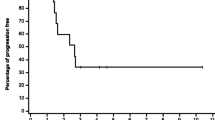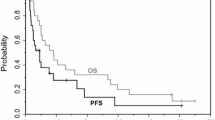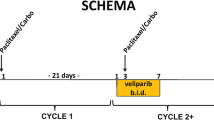Summary
In an effort of improve the therapeutic efficacy and selectivity of cyclophosphamide (CTX),cis-diamminedichloroplatinum(II) (CDDP), and carboplatin (Carbo), these antitumor alkylating agents were combined with the 2-nitroimidazole drug etanidazole (ETA). As revealed by tumor-cell survival assay in the FSaIIC murine fibrosarcoma, the addition of ETA (1 g/kg, i.p.) just prior to the i.p. injection of various doses of the alkylating agents resulted in increases in the tumor-cell kill produced by each drug (CTX, 10-fold; CDDP, 20-fold; and Carbo, 5-to 15-fold), whereas toxicity to bone marrow granulocytemacrophage colony-forming units (CFU-GM) increased only about 0- to 3-fold. When CTX was combined with either CDDP or Carbo, striking increases in tumor-cell killing were observed (20- to 100-fold across the CDDP dose range and 5- to 20-fold across the dose range of Carbo), which were supra-additive for CDDP and additive for Carbo as revealed by isobologram analysis. The addition of ETA to these alkylating-agent combinations produced a further approx. 20-fold increase in tumor-cell kill for both CTX/CDDP and CTX/Carbo. This effect was greatest at the lowest dose of the platinum drug tested and was supra-additive in the case of CDDP and additive for Carbo. Following treatment with ETA/CTX/CDDP, bone marrow CFU-GM toxicity increased only about 5-fold over that of CTX/CDDP alone, but the injection of ETA/CTX/Carbo resulted in a 10- to 20-fold increase in bone marrow toxicity as compared with that obtained using CTX/Carbo alone. Tumor growth-delay studies revealed significant increases in the antitumor effect of the alkylating agents when these were given in combination with ETA. Both the ETA/CTX/CDDP and the ETA/CTX/Carbo combinations produced tumor growth delays of 23 days, which represented approx. 1.6-fold increases over those obtained using the alkylating-agent combinations alone. These results suggest that ETA could significantly improve the therapeutic efficacy of these alkylating agents, whether they therapeutic efficacy of these alkylating agents, whether they are given individually or in combination.
Similar content being viewed by others
Abbreviations
- ETA:
-
etanidazole
- CTX:
-
cyclophophamide
- CDDP:
-
cis-diamminedichloroplatinum(II)
- Carbo:
-
carboplatin
- PBS:
-
phosphatebuffered saline
- FBS:
-
fetal bovine serum
- DMEM:
-
Dulbecco's minimal essential medium
- CFU-GM:
-
granulocyte-macrophage colony-forming units
References
Alberts DS, Green SJ, Hannigan EV, O'Toole R, Mason-Liddil N, Surwit EA, Stock-Novack D, Goldberg R, Malviya VK, Nahhas WA, Pugh RP, Guy JT, Dakhil SR (1989) Improved efficacy of carboplatin plus cyclophosphamide versus cisplatin plus cyclophosphamide: preliminary report by the Southwest Oncology Group of a phase III randomized trial in stages III and IV suboptimal ovarian cancer (abstract 588). Proc Am Soc Clin Oncol 8: 151
Berenbaum MC (1977) Synergy, additivism, and antagonism in immunosuppression. Clin Exp Immunol 28: 1
Bokkel Huinink WW ten, Rodenhuis S, Simonetti G, Dubbelman R, Franklin H, Dalesio O, Vermorken JB, McVie JG (1990) Studies with carboplatin in ovarian cancer: experience of the Netherlands Cancer Institute and GCCG of the European Organization for Research and Treatment of Cancer. In: Bunn FA, Canetta R, Ozols RF, Rozencweig M (eds) Carboplatin (JM-8): Current perspectives and future directions. Harcourt, Brace, Jovanovich, Philadelphia, pp 165–174
Carney DN, Teeling M (1990) Carboplatin plus cyclophosphamide for epithelial ovarian carcinoma. In: Bunn PA, Canetta R, Ozols RF, Rozencweig M (eds) Carboplatin (JM-8): current perspectives and future directions. Harcourt, Brace, Jovanovich, Philadelphia, pp 125–132
Coleman NC (1985) Hypoxic cell radiosensitizers: expectations and progress in drug development. Int J Radiat Oncol Biol Phys 11: 323–329
Deen DF, Williams MW (1979) Isobologram analysis of X-ray BCNU interactions in vitro. Radiat Res 79: 483
Dewey WC, Stone LE, Miller HH, Giblak RE (1971) Radiosensitization with 5-bromodeoxyuridine of Chinese hamster cells X-irradiated during different phases of the cell cycle. Radiat Res 47: 672
Eisenhauer EA, Swenerton KD, Sturgeon JF, Fine S, O'Reilly SE (1986) Phase II study of carboplatin in patients with ovarian carcinoma: a National Cancer Institute of Canada Clinical Trials Group study. Cancer Treat Rep 70: 1195–1198
Franko AJ (1986) Misonidazole and other hypoxia markers: metabolism and applications. Int J Radiat Oncol Biol Phys 12: 1195–1202
George M, Kerbrat P, Heron JF, Guastalla JP, Goupil A, Rey A, Toussaint C, Lhomme C, Chazard M, Lenaz L, Roussy I, Marquis C, Baclesse Caen C, Berard C, Huguenin C (1988) Phase I–II study of high-dose carboplatin as first-line chemotherapy of extensive epithelial overian cancer. Proc Am Soc Clin Oncol 7: 140
Herman TS, Teicher BA, Holden SA, Pfeffer MR, Jones SM (1990) Addition of 2-nitroimidazole radiosensitizers to trimodiality therapy (cis-diamminedichloroplatinum II/hyperthermia/radiation) in the murine FSaIIC fibrosarcoma. Cancer Res 50: 2734–2740
Kavanagh JJ (1990) Carboplatin in refractory epithelial ovarian cancer In: Bunn PA, Canetta R, Ozols RF, Rozencweig M (eds) Carboplatin (JM-8): current perspectives and future directions. Harcourt, Brace, Jovanovich, Philadelphia, pp 141–146
Laderoute KR, Eryavec E, McClelland RA, Rauth AM (1986) The production of strand breaks in DNA in the presence of the hydroxylamine of SR-2508 (1-[N-(2-hydroxyethyl)acetamido]-2-nitroimidazole) at neutral pH. Int J Radiat Oncol Biol Phys 12: 1215–1218
Litchfield JT, Wilcoxon FA (1949) A simplified method of evaluating dose-effect experiments. J Pharmacol Exp Ther 96: 99
McNally NJ (1982) Enhancement of chemotherapy agents. Int J Radiat Oncol Biol Phys 8: 593–598
Ozols RF, Ostchega Y, Curt G, Young RC (1987) High dose carboplatin in refractory ovarian cancer patients. J Clin Oncol 5: 197–201
Rice L, Urano M, Suit HD (1980) The radiosensitivity of a murine fibrosarcoma as measured by three cell survival assays. Br J Cancer 41: 240–245
Roizen-Towle L, Hall EJ, Piro JP (1986) Oxygen dependence for chemosensitization by misonidazole. Br J Cancer 54: 919–924
Rozencweig M, Martin A, Beltangady M, Bragman K, Goodlow J, Wiltshaw E, Calvert H, Mangioni C, Pecorelli S, Bolis G, Rocker I, Adams M, Canetta R (1990) Randomized trials of carboplatin versus cisplatin in advanced ovarian cancer. In: Burn PA, Canetta R, Ozols RF, Rozencweig M (eds) Carboplatin (JM-8): current perspectives and future directions. Harcourt, Brace, Jovanovich, Philadelphia, pp 175–186
Shea TC, Flaherty M, Elias A, Eder JP, Antman K, Begg C, Schipper L, Frei E III, Henner W (1989) A phase I clinical and pharmacokinetic study of carboplatin and autologous bone marrow support. J Clin Oncol 7: 651–661
Siemann DW (1984) Modification of chemotherapy by nitroimidazoles. Int J Radiat Oncol Biol Phys 10: 1585–1594
Speyer JL, Richards D, Beller U, Colombo N, Sorich J, Wernz J, Hochster H, Porges R, Muggia F, Canetta R, Beckman EM (1990) Trials of intraperitoneal carboplatin in patients with refractory ovarian cancer. In: Bunn PA, Canetta R, Ozols RF, Rozencweig M (eds) Carboplatin (JM-8): current perspectives and future directions. Harcourt, Brace, Jovanovich, Philadelphia pp 153–162
Steel GG, Peckman MJ (1979) Exploitable mechanisms in combined radiotherapy-chemotherapy: the concept of additivity. Oncol Biol Phys 15: 85–91
Tallarida RJ, Murray RB (1981) Manual of pharmacologic calculations with computer programs. Springer, New York Berlin Heidelberg
Teicher BA, Rose CM (1984) Perfluorochemical emulsion can increase tumor radiosensitivity. Science 223: 934–936
Teicher BA, Holden SA, Kelley MJ, Shea TC, Cucchi CA, Roswosky A, Henner WD, Frei E III (1987) Characterization of a human squamous carcinoma cell line resistant tocis-diamminedichloroplatinum(II). Cancer Res 47: 388–393
Teicher BA, Holden SA, Jacobs JL (1987) Approaches to defining the mechanism of Fluosol-DA 20% with carbogen enhancement of melphalan antitumor activity. Cancer Res 47: 513–518
Teicher BA, Herman TS, Holden SA, Jones SM (1989) Addition of misonidazole, etanidazole, or hyperthermia to treatment with Fluosol-DA/carbogen/radiation. J Natl Cancer Inst 12: 929–934
Teicher BA, Holden SA, Eder PJ, Brann TW, Jones SM, Frei E III (1989) Influence of schedule on alkylating agent cytotoxicity in vitro and in vivo. Cancer Res 49: 5994–5998
Teicher BA, Holden SA, Jones SM, Eder JP, Herman TS (1989) Influence of scheduling on two-drug combinations of alkylating agents in vivo. Cancer Chemother Pharmacol 25: 161–166
Teicher BA, Herman TS, Holden SA (1991) Effect of pH oxygenation and temperature on the cytotoxicity and radiosensitization by etanidazole. Int J Radiat Oncol Biol Phys 20: 723–736
Teicher BA, Holden SA, Al-Achi A, Hermann TS (1990) Classification of antineoplastic treatments by their differential toxicity toward putative oxygenated and hypoxic tumor subpopulations in vivo in the FSaIIC murine fibrosarcoma. Cancer Res 50: 3339–3344
Teicher BA, Pfeffer MR, Alvarez Sotomayor E, Herman TS (1991) DNA cross-linking and pharmacokinetic parameters in target tissues withcis-diamminedichloroplatinum(II) and etanidazole with or without hyperthermia. Int J Hypertherm (in press)
Teicher BA, Holden SA, Herman TS, Alvarez Sotomayor E, Khandekar V, Rosbe KW, Brann TW, Korbut TT, Frei E III (1991) Characteristics of five human tumor cell lines and sublines resistant tocis-diamminedichloroplatinum(II). Int J Cancer 47: 252–260
Author information
Authors and Affiliations
Additional information
This work was supported by National Cancer Institute grant PO1-37859, by a grant from the Mathers Foundation, and by a grant from Bristol Myers Inc., Wallingford, Connecticut
Rights and permissions
About this article
Cite this article
Teicher, B.A., Herman, T.S., Shulman, L. et al. Combination of etanidazole with cyclophosphamide and platinum complexes. Cancer Chemother. Pharmacol. 28, 153–158 (1991). https://doi.org/10.1007/BF00685502
Received:
Accepted:
Issue Date:
DOI: https://doi.org/10.1007/BF00685502




